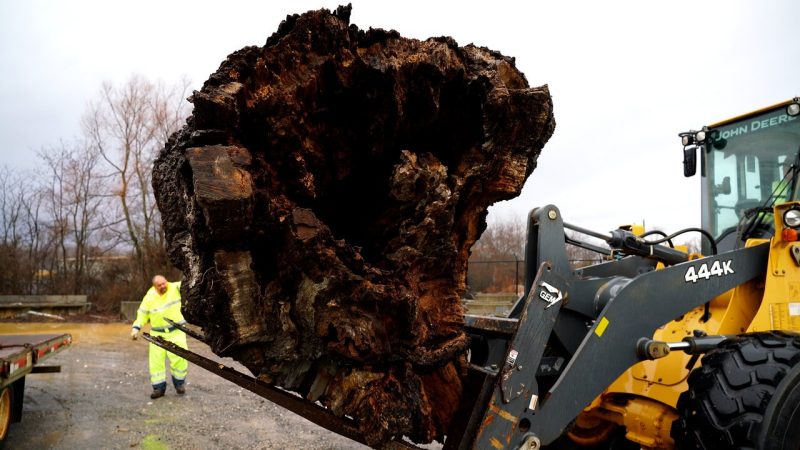Kerri Moseley-Hobbs recently traveled more than five hours to help with arrangements for a loved one.
“We look at the tree as an ancestor,” Moseley-Hobbs said of the historic Merry Oak. “That’s why I came down from Maryland to follow the tree, because it’s the same thing as when you have a family member pass away. You follow them through the funeral process.”
Moseley-Hobbs is a part of a universitywide, multiple-year effort to preserve the presence and legacy of the white oak, which was located on the grounds of Smithfield Plantation and claimed by a storm in May 2020. Estimated to be more than three centuries old and to have stood long before European colonists arrived, the Merry Tree, as it is commonly called, is thought to have become a sacred gathering place for the people enslaved at the plantation.
“The Merry Tree was the place or location in which the enslaved community would gather for meetings, religious ceremonies, and celebrations. And when I say celebrations, I also mean homegoing services and funerals,” said Moseley-Hobbs, whose four-times-grandfather Thomas Fraction was once enslaved at Smithfield.
Through the combined efforts of Virginia Tech, Smithfield Plantation, the Virginia Department of Forestry, and descendants of families formerly enslaved there, the crown of the tree has been removed and is now in the process of being crafted into two art installations. After extensive planning and discussions, this process officially began in late February.
“Since the storm hit and the tree went down, there has been a lot of discussion among university stakeholders and members of the Fraction family to ensure we treated this wood with the dignity it deserves,” said Wendy Halsey, assistant vice president for facilities operations at Virginia Tech. “While this is just the first step, our path forward will remain committed to collaboration, thoughtful planning, and respect.”
A ceremony at the Merry Oak site was held during 1872 Forward: Celebrating Virginia Tech from March 24-26. Spearheaded by the work of the Council on Virginia Tech History, the three-day celebration recognized the varied groups who helped shape Virginia Tech: Indigenous peoples, African Americans, and European settlers.
“Virginia Tech has grown up as an institution in Blacksburg on land that holds Native American, African American, and European American history and traditions,” said Menah Pratt-Clarke, vice president for strategic affairs and vice provost for inclusion and diversity. “The many people of this land, from 1872 forward, have contributed to our growth. … The events of the 1872 Forward weekend recognized and honored those who were here before us, who dreamed of what Virginia Tech might become, and whose stories can guide us into our future.”
The 1872 Forward event included both in-person and online offerings throughout the long weekend.
Moseley-Hobbs said she expected almost 100 decedents of the people once enslaved at Smithfield to attend events. Records indicate that the McNorton, Saunders, and Fraction families all resided on the site at some point, with the Fractions currently considered to have been the most numerous.
“We’re still finding other descendants to redevelop the families. We know that we [the Fractions] were a large family here, and now we’re also trying to help the McNorton family rebuild,” Moseley-Hobbs said.
In April 2019, the Virginia Tech Board of Visitors dedicated a building on campus to the families. The tiny, three-room building similar to the dwellings enslaved people lived in the 19th century is located at Solitude near the Duck Pond.
Moseley-Hobbs first reached out to the university to learn more about Thomas Fraction in 2016. Since then, she’s become a staple at events related to Smithfield and Solitude and has established the More than a Fraction Foundation, which co-sponsored the March event.
She said the Merry Oak resembled many of the trees in West Africa, the region from which her family was taken, so it made sense her relatives would have been drawn to it. She even felt a special connection to the Merry Oak during her earliest trip to Blacksburg.
“The first time I came to Smithfield, I paused and stared up at the tree from the top of the hill before I even knew what it was,” she said. “As we find other’s descendants and bring them there, there’s always an emotional reaction and connection to the tree.”
University Arborist Jamie King witnessed that connection firsthand during one of Moseley-Hobbs’ visits just prior to the Merry Oak’s tragic storm.
“I watched her walk up to the tree and lean into it,” King said. “It was quite a powerful moment, and later she told me a story about it.”
About two years later, Moseley-Hobbs still clearly recalls that moment.
“The tree looked like it had been trying to hold on [to life], and we just said to the tree, ‘You can go now,’” Moseley-Hobbs said. “And a couple months later, the wind hits it, and it goes.”
King said the tree most likely grew in response to winds from the west, as do most trees in the region. This, along with retrenchment — a process by which older trees naturally lose mass — and internal decay, made the Merry Oak very susceptible to the eastern winds of the storm in May 2020. Once claimed by the storm, discussions quickly began to determine the best way to preserve the tree and its legacy.
“When I came here in 2019, that tree was a huge priority. It was one of the first trees I went to see,” King said. “It’s likely the longest documented object at Virginia Tech, and I’m excited to see how this wood can keep telling this story.”


